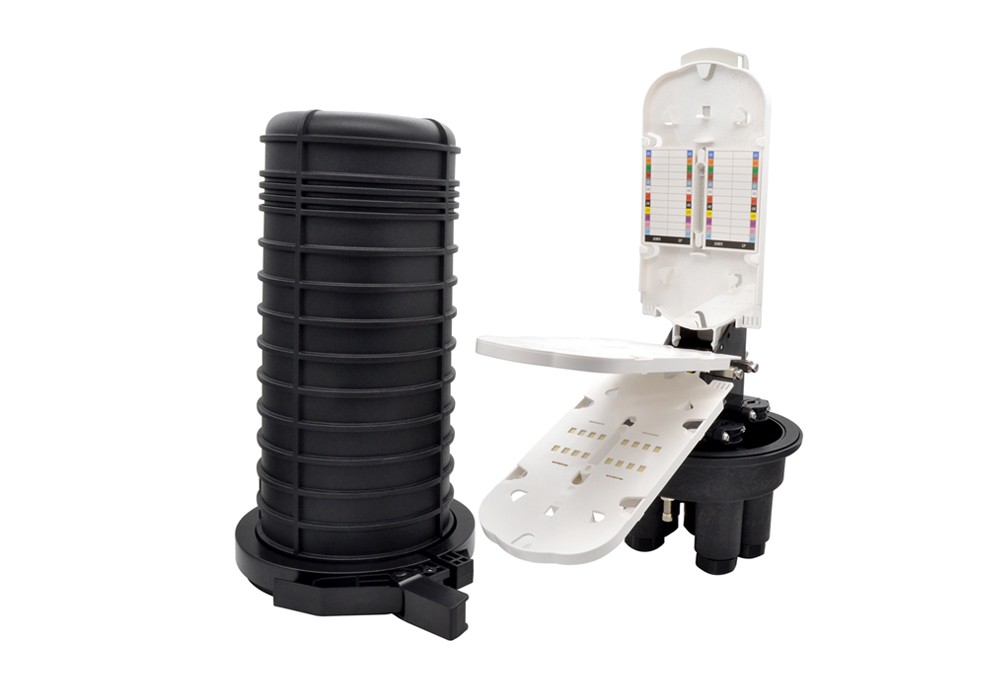
Dome Enclosures
A dome enclosure is a protective casing designed to house and safeguard fiber optic splices, connectors, and cables in outdoor environments. Shaped like a dome (hence the name), it’s built to withstand harsh conditions—think hurricanes, blizzards, or scorching heat. These enclosures are the "first responders" of fiber networks, shielding delicate components from: Weather: Rain, snow, UV rays. Physical damage: Vandalism, accidental impacts. Pests: Squirrels, birds, or insects looking for a cozy home. Commonly used in FTTH (Fiber-to-the-Home) networks or telecom infrastructure, dome enclosures are installed on poles, walls, or underground pedestals.
To understand how it works, let’s crack one open (metaphorically, of course):
Outer Shell:
Made of high-impact, UV-resistant plastic or metal.
Dome shape prevents water pooling and debris buildup.
Sealing System:
Rubber gaskets or O-rings create an airtight, waterproof seal (IP67 or higher rating).
Some models use gel seals for extra moisture resistance.
Splice Tray:
Organizes and protects fused fiber splices.
Often modular, allowing easy access without disturbing other fibers.
Cable Ports:
Entry points for incoming/outgoing fiber cables.
Strain relief clamps prevent cables from being yanked out.
Grounding Kit:
Protects against lightning strikes or power surges.
Why Dome Enclosures Are Non-Negotiable
1. Weatherproofing
Fiber splices are fragile—even a tiny water droplet can cause signal loss. Dome enclosures act like mini-fortresses, blocking:
Humidity: Prevents corrosion of metal components.
Temperature swings: Thermal stability protects adhesives and splices.
UV Degradation: The outer shell resists sun damage.
2. Faster Repairs
With everything organized in one place, technicians don’t waste time hunting for splices. One ISP reported a 50% reduction in repair times after standardizing dome enclosures.
3. Scalability
Need to add 10 new homes to the network? Dome enclosures come with extra ports and splice slots for easy expansion.
4. Safety
Lockable designs deter theft or tampering.
Grounding kits prevent electrical hazards.
Best Practices for Dome Enclosure Mastery
1. Choose the Right Enclosure
Climate: Use UV-stabilized enclosures in sunny areas, corrosion-resistant models near coastlines.
Capacity: Pick a size that accommodates future growth (e.g., 12-port vs. 24-port).
Mounting: Pole-mounted for aerial networks, pedestal-style for underground.
2. Installation Tips
Seal Like a Pro:
Use waterproof gel around cable entries.
Replace worn gaskets immediately—they’re the weakest link.
Mind the Bend Radius: Loop excess fiber loosely (no tight coils!).
Label Everything: Tag cables and splices with weatherproof labels.
3. Maintenance Routine
Every 6 Months:
Inspect seals and clean ports with isopropyl alcohol.
Check for cracks or fading (sun damage).
After Major Storms:
Verify no water infiltrated the enclosure.
Test splices with an OTDR for hidden damage.
643
0
734
172
